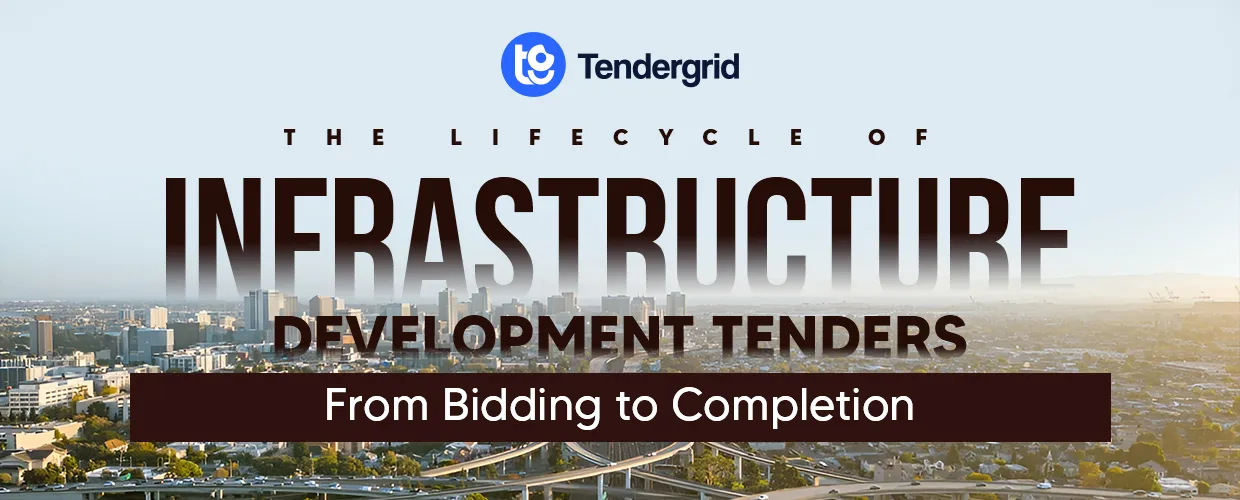Infrastructure development is a complex and multi-faceted process that involves various stages from planning to execution. However, we all know that any infrastructure project has a tendering process as its constituent part. Tenders are essentially formal offers made by contractors to undertake a specific project. Moving ahead, let’s understand the lifecycle of infrastructure development tenders, which go from bidding all the way to project completion. This is important for everyone who is involved in managing and overseeing such projects. So, in this Tender Grid blog, let's cover each stage together, providing insight as to what's involved, how one might manage this, and why it matters.
1. Pre-Tender Stage: Laying the Foundation
There is a lot of groundwork that needs to be done before the tender is even announced. It is more about planning and the feasibility study of the project. At this stage, the necessity for the project is evaluated against the goals it intends to achieve.
- Planning and Feasibility Studies : The pre-tendering phase starts with the identification of the need for the infrastructure project. Usually, a feasibility study is conducted to understand whether the project can be executed successfully. This includes technical, financial, and environmental feasibility. For instance, is there a real need for the road or bridge being proposed? How will it affect the local community, and will it be financially viable?
- Market Research and Regulatory Approvals : Once the feasibility of the project is established, market research is conducted. This involves looking at the current market conditions and identifying potential contractors who might be interested in bidding for the project. During this stage, it's also necessary to ensure that all necessary regulatory approvals and permits are obtained. Moreover, environmental impact assessments, local zoning laws, and building codes are just a few things that must be considered.
- Cost Estimation : Cost estimation during the pre-tender stage helps determine the overall budget for the project. A rough estimate is made of the expenses involved, including labour, materials, and equipment. This is a benchmark to compare with the bids that will come in later.
2. Tender Preparation: Drawing Up the Blueprints
Once all preliminary analysis has been done, the documentations for the infrastructure development tenders are prepared. In this regard, the company prepares its official Request for Tender (RFT) or Request for Proposal (RFP) to be issued to the potential contractors.
-
Tender Documentation : The tender documentation shall clearly outline the scope of work, timelines, and the specific deliverables expected from the contractor. These documents should be highly detailed, with specifications for all materials and the techniques of construction. This would ensure that the expectations of the client are clear and all bidders are on the same page.
-
Defining Criteria and Risk Assessment : After setting up the scope of work, it is essential to define the selection criteria. These criteria determine the evaluation of the bids and also consider contractor experience, cost, and quality. Furthermore, a thorough risk assessment should be done. All probable risks of delays, overruns in terms of cost, or technical complications should be pointed out during this stage.
3. The Tendering Process: Inviting the Contractors
Once the infrastructure development tenders documents are prepared, the actual process of tendering begins. In this process, the public or invited contractors are asked to submit their bids. Moreover, this process must be transparent and fair enough to get the most qualified contractor for the job.
-
Tender Announcement and Pre-Bid Meetings : The first step in the tendering process is to announce the tender and invite contractors to submit their bids. Public notice is usually given in newspapers or on digital platforms. Pre-bid meetings may be held to answer questions or clarify doubts that contractors might have about the project or the heavy construction machinery tenders documents. These meetings ensure that everyone has the same understanding of the project and reduce the chance of misunderstandings later on.
-
Bid Submission and Opening : After the pre-bid clarifications are carried out, bids are submitted by contractors, and the clients evaluate them carefully. The bids contain detailed proposals regarding how the contractor intends to carry out the project and at what cost. After the deadline for the submission, the bid is opened, and this is done usually in a public ceremony to maintain transparency.
4. Bid Evaluation and Selection: Selection of the Right Partner
After receiving all the bids, the next step is to analyze them. This is the most crucial phase, as the selection of the right contractor can either make or break a project.
-
Technical and Financial Evaluation : Evaluation of bids starts with an initial screening of the bids to make sure all necessary documents are available in one place. After this, the technical proposals are evaluated. This means analyzing the contractor's methodology, experience in past projects, and ability to meet the technical requirements of the project. Once the technical aspects are considered, the financial proposals are analyzed. At this point, it tries to assess whether costs are reasonable or fall within budget. Often, the lowest bid isn’t always the best option, especially if it compromises quality or timelines.
-
Compliance and Risk Evaluation : In addition to technical and financial analysis, the infrastructure development tenders are assessed on their legality, environmental safety, and health requirements. Financial evaluation is also conducted on the risk of the contractors in order to analyze the financial position of the contractors. In case the contractors have had delays or cost overruns, this can be a cause for concern.
-
Granting the Contract : After doing a thorough evaluation, the contract is awarded to the winning bidder. This contractor is selected according to their abilities to deliver the project on time, within budget, and as per the required specifications.
5. Contract Negotiation and Signing: Closing the Deal
After selecting the bidder, the negotiations begin to finalize the terms of the contract with them. This is a crucial stage for both parties so that they will agree on the specific terms that help in the execution of the project.
-
Finalizing Terms and Conditions : The final contract includes essential details that include project timelines, payment schedules, penalties for delays, and quality requirements. This stage is also important to align the expectations and address all the concerns before the project begins.
-
Legal Review and Signing the Agreement : Before signing a contract, legal representatives from both sides review the draft to ensure the contract is binding, thus protecting the interests of both parties. Once agreed on all terms, it is signed into effect, hence marking the formal commencement of a project.
6. Project Mobilization and Execution: Building the Infrastructure
After signing the contract, the contractor can begin the work. This stage involves mobilizing resources, preparing the site, and starting construction work.
-
Site Preparation and Resource Mobilization : Site preparation includes clearing land, setting up the necessary infrastructure, and organizing the workforce. To do so, they need resources such as labor, equipment, and materials, so that should also be mobilized.
-
Project Management and Progress Monitoring : The contractor's project management team oversees the whole process to ensure that all work stays on schedule and within budget. The contractor maintains and updates the regular progress reports and, at appropriate times, quality control measures to monitor performance and address issues as they arise.
7. Completion and Handover: Finalizing the Project
After months or years of work, the project eventually nears completion. And this is why the final stages of an infrastructure project are very crucial to ensuring that everything is up to standard and ready for use.
-
Final Inspections and Testing : All work should be finalized according to the standards required before the project is finally handed over to the client. This involves checking the infrastructure for functionality and safety.
-
Documentation and Handover : After the inspection, all the relevant documents that include maintenance manuals, warranties, and design drawings are handed over to the client. The infrastructure is now ready for use.
-
Defects Liability Period : Many contracts include a defects liability period; during this period, the contractor remains responsible for fixing any issues that arise after completion. This is normally a short period but very necessary for ensuring that the infrastructure remains in good condition.
8. Post-Completion Evaluation: Reflecting on the Project
After the project is completed, it’s important to conduct a post-completion evaluation to assess how well it was executed.
-
Performance Review : This entails evaluation of the original objectives against performance, whether it met the set timeframe, budgeted cost, and even specifications.
-
Lesson Learned : The final step is always to identify the lessons learned through the project. What worked well? What can be improved? These precious lessons might help in further improvement of any future infrastructure-related projects.
Searching for Infrastructure Development Tenders? Visit Tender Grid Now!
The process of developing infrastructure development tenders is detailed and rigorous. From planning and preparing to project execution and post-completion evaluation, each stage calls for careful attention and coordination. That’s why understanding what is involved, from preparation of heavy construction machinery tenders to post-completion evaluation, can help organizations to better manage projects in the most risk-free ways. Also, this way they can deliver quality infrastructure that endures to serve its intended functions for years to come. Therefore, if you are also planning to participate in infrastructure development tenders and require all the related documents to be read in one location, you can visit Tender Grid.
Read More Blogs:-
1. A Comprehensive Guide to Win GeM Tenders in 2025
2. New Year Government Tender Opportunities: Key Sectors to Focus On

